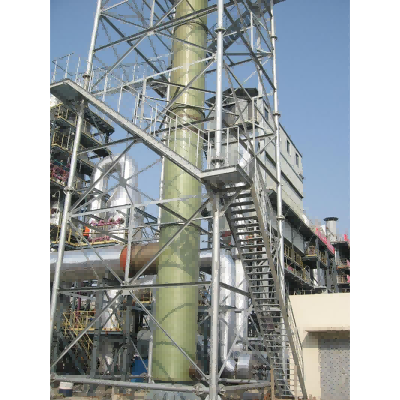Advantages of Fiberglass Chimney Tower
2024-07-09
A fiberglass chimney tower, also known as a fiberglass chimney stack or chimney column, is a structure used in various industrial applications, particularly in facilities where emissions need to be vented safely into the atmosphere. Here’s a detailed overview of fiberglass chimney towers, including their construction, advantages, applications, and considerations:
Construction and Design
1. Materials
- Fiberglass Reinforced Plastic (FRP): Made from layers of fiberglass strands embedded in resin.
- Resin Types: Typically polyester or vinyl ester resins, chosen for their corrosion resistance and durability.
2. Structure
- Layers: Consists of multiple layers of fiberglass and resin, often with an outer gel coat for UV protection.
- Reinforcements: May include additional structural reinforcements like ribs or flanges for strength.
- Lining: Inner lining may be added for enhanced chemical resistance or insulation.
3. Components
- Base and Support: Typically includes a base structure for mounting on the ground or a foundation.
- Accessories: Options for platforms, ladders, lightning protection, and service platforms depending on the application.
Advantages
1. Corrosion Resistance
- Explanation: Fiberglass is highly resistant to corrosion from chemicals, moisture, and gases.
- Result: Suitable for environments with corrosive emissions, such as chemical plants or industrial facilities.
2. Lightweight
- Explanation: Fiberglass is significantly lighter than traditional materials like steel or concrete.
- Result: Easier and more cost-effective to transport, handle, and install.
3. Durability
- Explanation: Resistant to UV degradation, weathering, and temperature extremes.
- Result: Long service life with minimal maintenance compared to metal or concrete structures.
4. Insulation Properties
- Explanation: Provides natural insulation, reducing heat loss or condensation issues.
- Result: Maintains stable internal temperatures, beneficial for emissions control and efficiency.
5. Design Flexibility
- Explanation: Easily molded into various shapes and sizes to meet specific project requirements.
- Result: Allows for customization and integration with existing infrastructure.
6. Environmental Benefits
- Explanation: Fiberglass is non-corrosive and does not leach chemicals, contributing to environmental sustainability.
- Result: Lower environmental impact compared to materials requiring coatings or maintenance chemicals.
Applications
1. Industrial Ventilation
- Use Case: Exhaust stacks for venting emissions from manufacturing processes.
- Reason: Provides safe and efficient dispersion of pollutants into the atmosphere.
2. Power Plants
- Use Case: Chimney stacks for exhaust gases from boilers and turbines.
- Reason: Handles high-temperature exhaust gases and provides corrosion resistance.
3. Chemical Processing
- Use Case: Stacks for releasing chemical vapors and gases safely.
- Reason: Resistant to corrosive chemicals and provides reliable emissions control.
4. Wastewater Treatment
- Use Case: Stacks for releasing odorous gases and steam from treatment processes.
- Reason: Handles corrosive gases and maintains structural integrity in humid environments.
5. Incinerators
- Use Case: Stacks for exhaust gases and particulates from waste incineration.
- Reason: Withstands high temperatures and corrosive combustion by-products.
Considerations
1. Design Standards
- Explanation: Ensure compliance with local regulations and industry standards for emissions control and structural integrity.
- Result: Ensures safe operation and regulatory compliance.
2. Installation and Maintenance
- Explanation: Proper installation and regular inspection are crucial for long-term performance.
- Result: Prevents issues such as leaks, structural damage, or reduced efficiency.
3. Structural Requirements
- Explanation: Consider wind loads, seismic factors, and other environmental conditions when designing and installing.
- Result: Ensures stability and safety of the chimney tower under all operating conditions.
4. Cost Considerations
- Explanation: Initial costs may be higher than traditional materials, but savings in maintenance and longevity should be considered.
- Result: Total cost of ownership analysis helps justify the investment in fiberglass chimney towers.
Conclusion
Fiberglass chimney towers offer a durable, corrosion-resistant, and lightweight solution for venting emissions in industrial applications. Their versatility, design flexibility, and environmental benefits make them a preferred choice for facilities requiring reliable and efficient emissions control. Proper design, installation, and maintenance are essential to maximize the performance and longevity of fiberglass chimney towers in various industrial environments.



